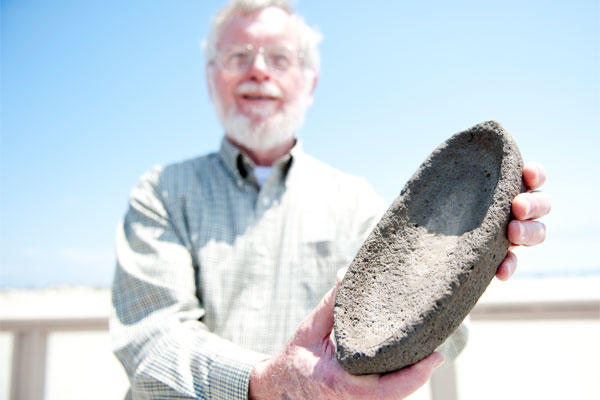SAN CLEMENTE ISLAND, Calif. -- More than 1,000 years ago a Native American began carving his way into history. He started with a single stone made from submarine volcanic material. A rare form of lava that differs from the molten rock that flows on the mainland because it's harder and the vesicles, or tiny holes, are smaller making it more brittle.
However, the determined native spent hours and hours picking and grinding to manipulate the material, being careful not to break it. His final product was of a small boat carving, or effigy, used by the California Indians who occupied the California Channels and adjacent southern California mainland at the time of the Spanish "discovery" in the 1500s.
The Navy discovered this significant prehistoric artifact 90 miles west of San Diego on San Clemente Island (SCI) located mid-island on the surface of a newly discovered archaeological site.
Dr. Andy Yatsko, Senior Archaeologist and Region Southwest Archaeologist for the Naval Facilities Engineering Command Southwest in San Diego, has more than 40 years of experience in prehistoric and historic archaeology and finds the boat effigy to be unusual, yet exhilarating.
"Boat effigies like the one found are exceedingly rare in the archaeological record, with this being my first one recovered during my 30 year tenure with SCI," said Yatsko. "Finding artefact's on the surface of archaeological sites at the island is not unusual, but a rare one like this is always exciting to come across."
The effigy represents a traditional sewn plank canoe, or "ti'at" in the Gabrielino language. These canoes were typically built of redwood obtained from driftwood (whole trees) that came south from the rivers in northwestern California. The redwood was split into long, narrow planks that were joined along their edges with fiber rope and caulked with natural asphalt. They ranged in size from 8 to 30 feet, and were propelled by paddling, not sails, making the trip between the islands physically demanding.
As a federal agency, the Navy has responsibilities to be knowledgeable and understand what it owns when it comes to its property. In order to meet their expectations the Navy contracts archaeologists to survey the land to protect rare gems and parts of history such as the boat effigy.
"Our cultural and natural resource programs are such that we continue to excel in protecting the natural and man-made treasures entrusted to our care while allowing our operational forces to train as they fight on SCI," said Capt. Gary Mayes, commanding officer, Naval Base Coronado.
"If you were to draw a straight line in any direction on the landscape of SCI you would hit an archaeology site within 100-150 meters," said Yatsko.
So while the service members train, archaeologists are surveying the ruins, digging through the rubble, and examining their finds from more than 7,600 archaeological sites on the island.
"To the untrained eye archaeology sites on the island aren't very sexy," said Yatsko. "To the general public it's just different colors of dirt with shells and rubble, but as scientists we look at the value of the deposits and see the beauty."
Yatsko added, discovering objects that are as recognizable as the boat effigy is important so the general public will appreciate what the Navy is trying to get out of the archaeology by revealing the history of the island.
"This is a way to touch those people in the past," said Yatsko. "It is something someone made representing a high skill level. This guy wasn't just a technician he was an artist. When someone holds this [boat effigy] he or she will think about someone 500 to 1000 years ago."
"NBC takes great pride in making this discovery that adds to our knowledge of the Native Americans that once called SCI home," said Mayes.
SCI has the last remaining shore bombardment range, in and out of the continental U.S., where Navy ships can qualify for naval gunfire support by actually shooting from ships to targets on land. It is also the last place where Marine Corps and Navy fire support forward observers can directly train for naval gunfire support roles making SCI critical because the physical dynamics of high-velocity naval gunfire are significantly different.





























